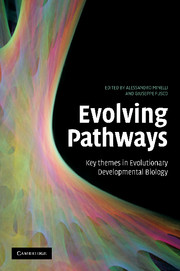Book contents
- Frontmatter
- Contents
- Contributors
- Preface
- Introduction: Pathways of change
- Part I Thinking about evolution by taking development on board
- 1 Evo-devo as a discipline
- 2 Making evolutionary predictions about the structure of development and morphology: beyond the neo-Darwinian and constraints paradigms
- 3 Conflicting hypotheses on the nature of mega-evolution
- 4 Prospects of evo-devo for linking pattern and process in the evolution of morphospace
- 5 The molecular biology underlying developmental evolution
- 6 Evo-devo's identity: from model organisms to developmental types
- Part II Evo-devo: methods and materials
- Part III Evolving diversity
- Part IV Evolving body features
- Index
- References
4 - Prospects of evo-devo for linking pattern and process in the evolution of morphospace
Published online by Cambridge University Press: 08 August 2009
- Frontmatter
- Contents
- Contributors
- Preface
- Introduction: Pathways of change
- Part I Thinking about evolution by taking development on board
- 1 Evo-devo as a discipline
- 2 Making evolutionary predictions about the structure of development and morphology: beyond the neo-Darwinian and constraints paradigms
- 3 Conflicting hypotheses on the nature of mega-evolution
- 4 Prospects of evo-devo for linking pattern and process in the evolution of morphospace
- 5 The molecular biology underlying developmental evolution
- 6 Evo-devo's identity: from model organisms to developmental types
- Part II Evo-devo: methods and materials
- Part III Evolving diversity
- Part IV Evolving body features
- Index
- References
Summary
Evolutionary developmental biology or evo-devo will make crucial contributions over the coming years to exploring the occupancy of morphospace. Why do species show the patterns of diversity and disparity they do, and to what extent do such patterns reflect the ways in which phenotypic variation is generated as well as the processes of natural selection? Evo-devo in appropriate study systems is providing the means to explore fully how phenotypic variation is generated by the processes intrinsic to individuals, especially those of development. Substantial progress will be made in understanding the occupancy of morphospace if the results of this type of evo-devo can then be combined with analyses of how this same variation is influenced by natural selection and other extrinsic processes to result in the patterns of evolution. Use can also be made here of recent advances in developing appropriate null models for testing adaptive versus neutral or random-walk explanations of evolution (Pie and Weitz 2005).
In combination, this type of broad evo-devo and evolutionary biology can begin to unravel how evolvability, the capacity to evolve at the genetical and developmental levels, contributes to shaping the evolution of patterns of diversity and disparity in phenotypic space (Brakefield 2006). We will then be able to examine the extent to which such phenomena as genetic channelling, developmental bias and developmental drive are reflected in patterns of evolution, whether involving change or stasis (e.g. Maynard Smith et al. 1985, Schluter 1996, Wagner and Altenberg 1996, Arthur 2001, Blows and Hoffman 2005).
- Type
- Chapter
- Information
- Evolving PathwaysKey Themes in Evolutionary Developmental Biology, pp. 62 - 79Publisher: Cambridge University PressPrint publication year: 2008
References
- 1
- Cited by



